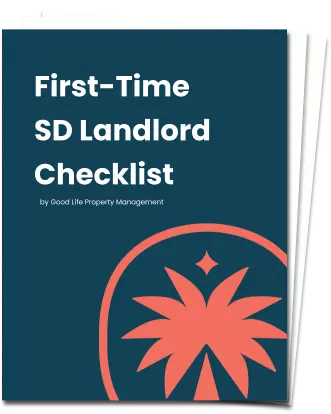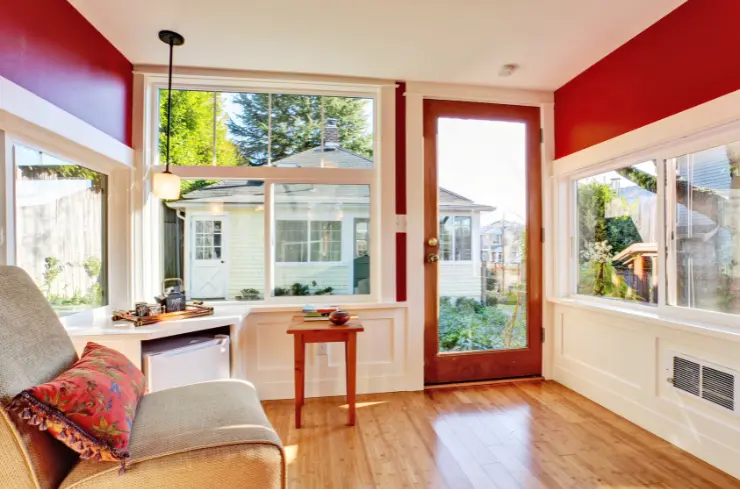If you’re getting ready to become a landlord in San Diego, then you’ve come to the right place. There is a lot of responsibility that comes with being a landlord, and when you’re doing it for the first time, it’s hard to know what you don’t know.
That’s why we put together this ultimate guide to becoming a landlord for first time landlords in the San Diego area. We’re going to walk you through the essential steps every first-time landlord should be taking—from getting your property rent-ready to understanding your budget and screening tenants. If you follow these steps, you’ll be well on your way to becoming a successful landlord with happy tenants and a strong long-term investment.
Key takeaways
- It’s important to conduct thorough inspections, cosmetic updates, and a deep clean to get your property rent-ready.
- Using a competitive market analysis to set the right rental price is the most effective way to ensure your property is priced competitively to maximize your ROI.
- Staying up-to-date on local, state, and federal landlord-tenant laws is essential to keep your property compliant.
- Working with a property management company can take the stress out of managing your rental property.
Table of Contents
- Step 1: Prepare Your Property for Rent
- Step 2: Set Your Rental Rate
- Step 3: Analyze Your Fixed and Variable Costs
- Step 4: Research and Buy Landlord Insurance
- Step 5: Understand San Diego Landlord-Tenant Laws
- Step 6: Market Your Property
- Step 7: Screen Potential Tenants
- Step 8: Create and Sign Your Lease Agreement
- Step 9: Collect Rent
- Step 10: Ongoing Management and Financial Reporting
- Download Your Free First-Time Landlord Checklist
- First-Time Landlord FAQs
Step 1: Prepare Your Property for Rent
Getting your property ready to rent might be more challenging than it looks at first. It’s more than just cleaning the property, you need to see the property through the eyes of your potential tenants and get it in the best shape possible.
We always recommend property owners start with a thorough inspection of their property. Inspect the property from top to bottom to ensure everything is in working order.
- Check all essential systems, like plumbing, heating, air conditioning, electrical and HVAC, are in working order.
- Check that all appliances, like the refrigerator, oven and dishwasher, are in working order.
- Ensure there are no leaks or mold issues at the property.
- Check for any structural damage or deferred maintenance issues
- Test all electrical outlets to make sure they’re working
- Test smoke detectors and carbon monoxide detectors
- Treat for any pest infestations
- Verify compliance with local building codes
After you’ve inspected all of the above, take some time to make aesthetic changes to the property. These small—but mighty—improvements can make a big impact on potential tenants.
- Paint the walls
- Update light fixtures
- Patch small holes and cracks
- Replace window treatments
- Upgrade cabinet hardware
While these above changes are not required by law to complete, they can help your property stand out in a saturated market.
Lastly, give your property a deep clean—go through the property and ensure everything is as clean as it can be. From the windows to the baseboards to the cabinets to the floors, the entire property should be cleaned before you start showing the property.
Step 2: Set Your Rental Rate
Setting the best price for your rental property is key to getting your property rented quickly and making a healthy return on your investment. Pricing your property can feel intimidating for first time landlords, but using a comparable market analysis (CMA) can make it a lot easier.
A CMA looks at properties that have recently rented or are listed to rent and analyzes four main factors:
- Rental properties with similar square footage, number of bedrooms, and amenities.
- The property’s location.
- The age of the property.
- The condition of the property.
When you analyze properties in your area that have similar characteristics to your rental, you can learn what other properties are being rented for. This information can help you set a competitive price that will attract tenants and, ultimately, give you a strong ROI. By looking at both properties that are currently on the market and those that have recently been leased, you can get a clear picture of rent rates that get leased. If you see a comparable property but it’s been on the market for over a month, this might be an example of a property that’s priced too high.
Step 3: Analyze Your Fixed and Variable Costs
It’s essential to understand the costs that are associated with owning and operating a rental property. Once you have a grasp on all the costs, you need to create a budget for both fixed and variable expenses. When you build a budget that has some cushion for emergencies, you’re more likely to have a financially sustainable budget that makes room for things to go wrong.
Fixed Costs:
- If you have a mortgage on your property, the mortgage payments will be one of your largest fixed costs.
- In San Diego, property taxes are based on the assessed value of the property. They are typically due twice a year and can increase year-over-year.
- Landlord insurance is essential for protecting your investment and is a fixed cost.
- If your property is part of a homeowners association, you’ll need to pay HOA dues.
- Property management fees are usually a percentage of the monthly rent (typically around 8-10%).
Variable Costs:
- Maintenance and repair costs fluctuate depending on a variety of factors including age and condition of the property, and the type of maintenance or repair.
- If you pay some or all of the utilities, these costs will fluctuate based on usage and the number of tenants in the property.
- During vacancy, you’ll need to cover mortgage payments, insurance, and utilities, but won’t be receiving rental income. These costs are called vacancy costs.
- Legal fees (for evictions, lease agreements, etc.) and administrative fees (for advertising, tenant screening, etc.) vary depending on the situation.
Step 4: Research and Buy Landlord Insurance
Purchasing landlord insurance is an integral step for every first time landlord. Landlord insurance is designed specifically to help protect landlords—it protects the property, your personal property, loss of rental income, and protects you against liability.
It’s important to spend some time researching insurance providers and policies to ensure you get a policy that gives you the coverage you need for your rental property.
Step 5: Understand San Diego Landlord-Tenant Laws
There are a lot of laws and regulations that surround rental properties and landlord-tenant relationships in California and San Diego. Not to mention, the laws are constantly changing and being updated. It can be overwhelming to stay on top of these laws and regulations. But the importance of understanding and staying compliant with landlord-tenant laws shouldn’t be underestimated. The consequences of not complying can be expensive and time-consuming.
San Diego is a tenant-friendly state, so if you fail to follow regulations, you can find yourself with expensive fines or a lengthy, costly legal battle.
Here are some of the laws that should be on your radar as a landlord in San Diego:
- Security deposits are governed by California law and states that landlords can only charge a maximum of one month’s rent as a security deposit.
- San Diego follows California’s rent control laws that limit rent increases on properties built before 2005 cannot exceed 5% + the percentage change in the cost of living over the previous year’s Consumer Price Index (CPI).
- Evictions are very in-depth legal processes. If you think you need to evict a tenant, consult with a real estate attorney to make sure you follow all applicable laws.
- California’s fair housing laws help ensure there’s no discrimination in the rental process. These laws work to ensure no one is discriminated against based on their race, religion, gender, disability, and more.
Step 6: Market Your Property
Now that your property is rent-ready, you can start to market it and look for tenants. The most effective way to market your property is listing it on popular online rental websites like Zillow, Apartments.com, and Craigslist. Spend some time crafting the perfect listing that includes a detailed—and accurate—description, and highlights key features like amenities, location benefits, and any unique selling points.
A picture is worth a thousand words, so get some high-quality, well-lit photos of your property. You can also include video and 3D tours to give your potential tenants a visual representation of what the property looks like. Effectively marketing your property is about more than throwing up a quick listing—it’s about creating a listing that stands out from the crowd and gets the attention of the kind of reliable tenants you’re looking for.
Step 7: Screen Potential Tenants
The tenant screening process is essential to helping you choose responsible, reliable tenants who will pay rent on time and take care of your property. The screening process typically includes:
- Reviewing the tenant’s rental history.
- Checking credit scores.
- Verifying income.
- Conducting background checks for criminal history or past evictions.
- Contacting references from previous landlords to gauge their reliability and behavior as tenants.
With a thorough tenant screening process, you can decrease the risk of late payments, property damage, disputes, and evictions.
There are state laws that must be followed during the screening process. Landlords are required to get written consent from an applicant before running credit or background checks. Also, California’s Fair Housing Act prohibits landlords from discriminating against applicants based on race, gender, religion, sexual orientation, or other protected classes.
Step 8: Create and Sign Your Lease Agreement
The purpose of a lease agreement is to protect the landlord and tenants. When written properly, a lease sets clear expectations and defines the terms of the rental arrangement, including rent payments, maintenance responsibilities, lease duration, and other important rules.
As a landlord if you enter into a “lease” without an actual written lease agreement, you can find yourself in legal disputes over everything from late fees and security deposits to handling property damage. A legally binding lease agreement will help to minimize misunderstandings and help provide a framework that you can use to resolve potential issues.
Working with a property management company like Good Life can save time and ensure that the lease agreement meets all necessary requirements and protects your interests. Alternatively, you can work with a legal professional who specializes in landlord-tenant law.
Step 9: Collect Rent
In your lease agreement, it should be noted when rent is due each month. It should also state how you accept rent payments—it can be helpful to offer various payment options for tenants. Whether you offer an online payment portal, checks, or some other form of accepting payment, this should all be clearly outlined in the lease agreement.
Late fees should also be outlined in the lease so that you avoid confusion and ensure both you and your tenants are on the same page. This will also help ensure that rent is paid on time.
Step 10: Ongoing Management and Financial Reporting
Once you have tenants in your rental property, your focus shifts from actively seeking applicants to managing tenants. Having a system in place for handling tenant requests, staying informed about landlord-tenant laws, and managing issues before they escalate can help make the day-to-day management of your property more efficient.
You’ll also need to put yourself in the role of “accountant” to keep track of your rental income and expenses to stay compliant with IRS regulations. This can help you minimize your tax liability while ensuring you get the best possible return on investment.
If you’re looking for help creating a system to help manage your company, look no further than a property management company. Property managers have their own systems in place that take the hassle out of ongoing property maintenance. They handle everything from routine upkeep to emergency repairs, ensuring your property stays in top shape without you lifting a finger. Many management companies also help track your finances with regular financial reports so you always have a clear picture of how your rental property is doing.
Download Your Free First-Time Landlord Checklist
At Good Life Property Management, we understand how stressful being a first-time landlord can be. And we just gave you a lot of information to process. To make it easier, we’ve pulled together a free first-time landlord checklist so you can ensure you tick all the important boxes.
At Good Life Property Management, we believe life should be enjoyed, not spent sweating the small stuff. That’s why we set out to make property management easy. We care about you, your property, and your tenant. And we do it all so you can Live the Good Life.
If you need help managing your rental property, schedule a call to speak with one of our Good Life experts.

First-Time Landlord Checklist:
Free Downloadable PDF
Fill out the form below to instantly download our first-time San Diego landlord checklist.
First-Time Landlord FAQs
What is the hardest part about being a landlord?
Being a landlord can be difficult, but managing tenant issues, property maintenance and repairs, and ensuring rent is paid on time are often seen as the most difficult parts of the job.
What is the minimum credit score a landlord should accept?
While there is no set rate, most landlords look for credit scores from 620 to 650, but this does depend on the type of property and the local rental market.
Can you ask for a deposit before signing a lease?
Landlords in California can ask for a security deposit before a lease is signed, but tenants do not have to provide it before signing the lease agreement.
How much income do most landlords require?
Most landlords in San Diego require their tenants’ net monthly income to be 2.5 times the monthly rent they’re expected to pay to help ensure they will be able to pay each month.
Steve Welty
Subscribe to our Weekly Newsletter
Join the 5k+ homeowners receiving Local Law Updates and Landlord Tips. Delivered to your inbox every Saturday at 6am PST.
Share this:
Get in touch with us:
We make owning rental property easy.
Choose Your Next Step
Good Life Blogs
We believe that education is empowering.

Best Property Management Companies in Central San Diego
There are many property management companies in San Diego and it can be hard to narrow down which one is right for you. We’re here to help you with that

The Best & Worst California Burritos in Pacific Beach, San Diego
We’re back with a list of the best and worst California burritos in the neighborhood of Pacific Beach, San Diego, California.

New Short-Term Rental Regulations in San Diego
San Diego has recently passed an ordinance that will reduce the number of short-term rentals by nearly 6,000. What does this mean for property owners?






